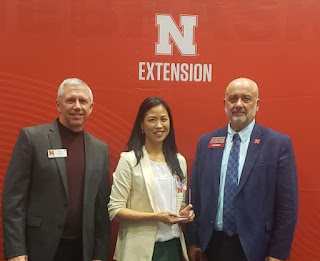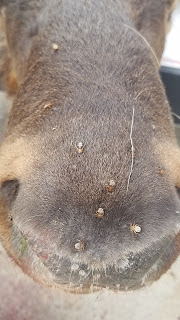Today's episode is a special treat as we invite our very own, Michael Skvarla to swap his host hat for a guest's chair. For years, Jody has wanted to pick Mike's brain about deer keds, a topic both she and Jonathan know little about. Luckily, over the past few years, Mike has become something on an expert on the topic. Tune in to learn all about these ectoparasitic, wingless, and interesting flies and how they live, thrive, and survive (plus a little about when people run into them).
 |
| It's us! Talking about deer keds! |
Also wanted to give a big shoutout to Jody for winning an award for excellence in Extension for her efforts in Nebraska and around the country. We're very proud of her and her commitment to science communication and we hope you will drop her a note of congratulations!
Show Notes
CONTENT WARNING: DEAD ANIMALS.
All photographs by Michael Skvarla unless otherwise noted.
European deer ked (Lipoptena cervi). Mammal-feeding deer keds emerge with wings but shed them after landing on a host. Photo by Erika Machtinger, Penn State University.

European deer ked on a white-tailed deer. This ked has shed it's wings. The abdomen has expanded after it took a blood meal.
European deer ked on a white-tailed deer.
European deer keds on the muzzle of an elk. This photo was not staged, the keds were just very abundant.
Michael and Penn State Vector Ecology Lab personnel searching for deer keds on a white-tailed deer at deer processors across Pennsylvania. Photos by Erika Matchinger and Michael Skvarla, Penn State University.
We searched through literal piles of deer.
The easiest way to find deer keds on host is to part the hair in sequence like you're sifting through papers in a file folder. We found that the best way to do that quickly was using a louse comb. Fine forceps are then used to grab the ked before it "swims" back into the hair.
Pennsylvania elk at the PA Game Commission elk check station. Deer keds will land on any cervid, including deer and elk. Elk season in Pennsylvania is earlier than deer rifle season, so gave us an opportunity to collect deer keds a few weeks earlier than usual.
Neotropical deer keds on a white-tailed deer harvested in Tennessee. Similar to European deer keds in Pennsylvania, some deer in Tennessee were loaded with keds while others were comparatively clean.
Example of a PA Parasite Hunters collection kit that was sent to hunters to collect ticks and deer keds from deer they harvested.
To test if deer keds responded to common insect repellents such as DEET, we marked off sections on a sock, applied the repellent, put the sock over an arm, and allowed keds to freely climb from an arena up the sock. At the end of 5 minutes we scored if they crossed the repellent or not.
Questions? Comments?
If you can spare a moment, we appreciate when you subscribe to the show on those apps or when you take time to leave a review!
Subscribe to our feed on Feedburner!
Beginning/ending theme: "There It Is" by Kevin MacLeod (incompetech.com) Licensed under Creative Commons: By Attribution 3.0



















